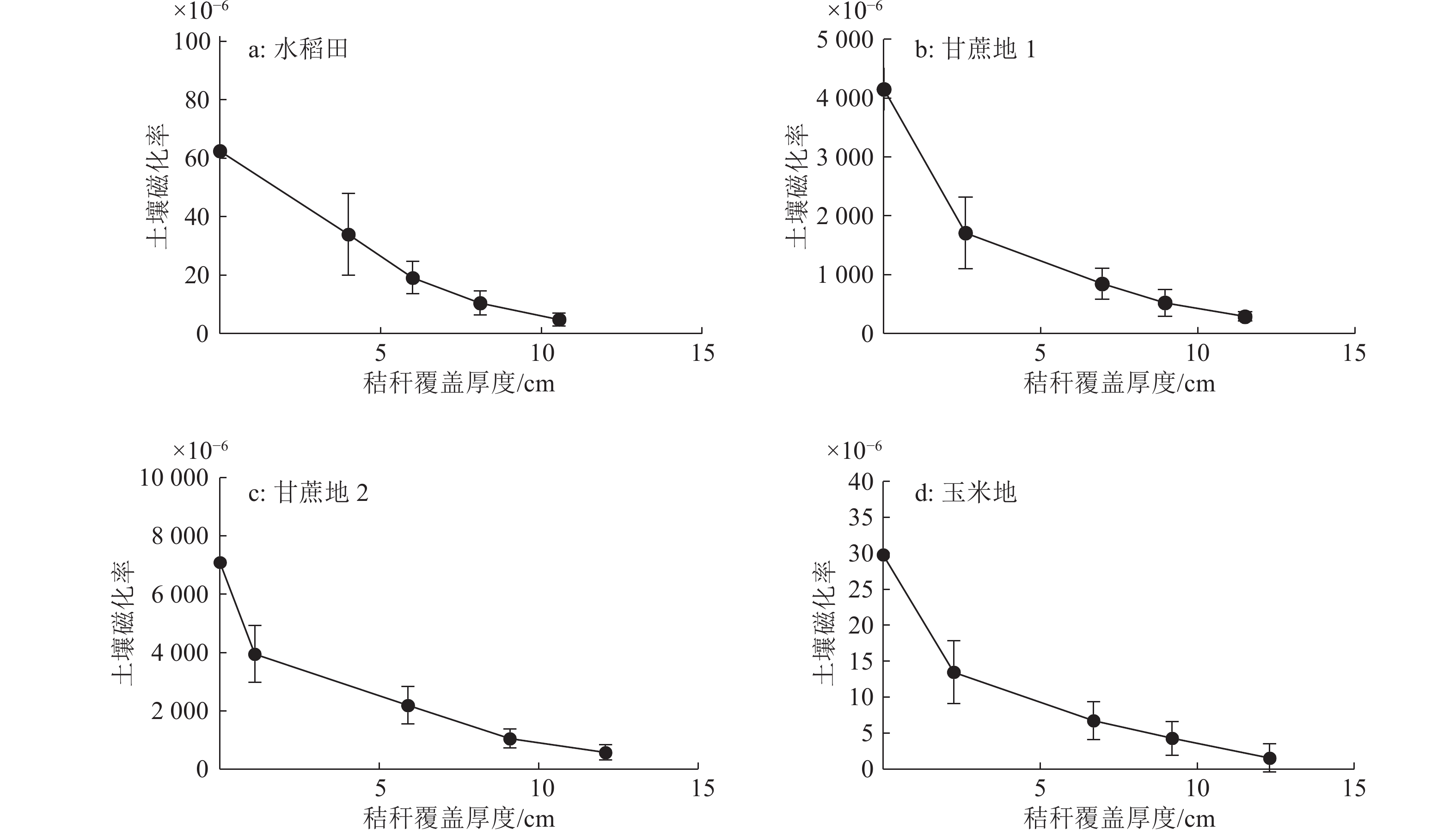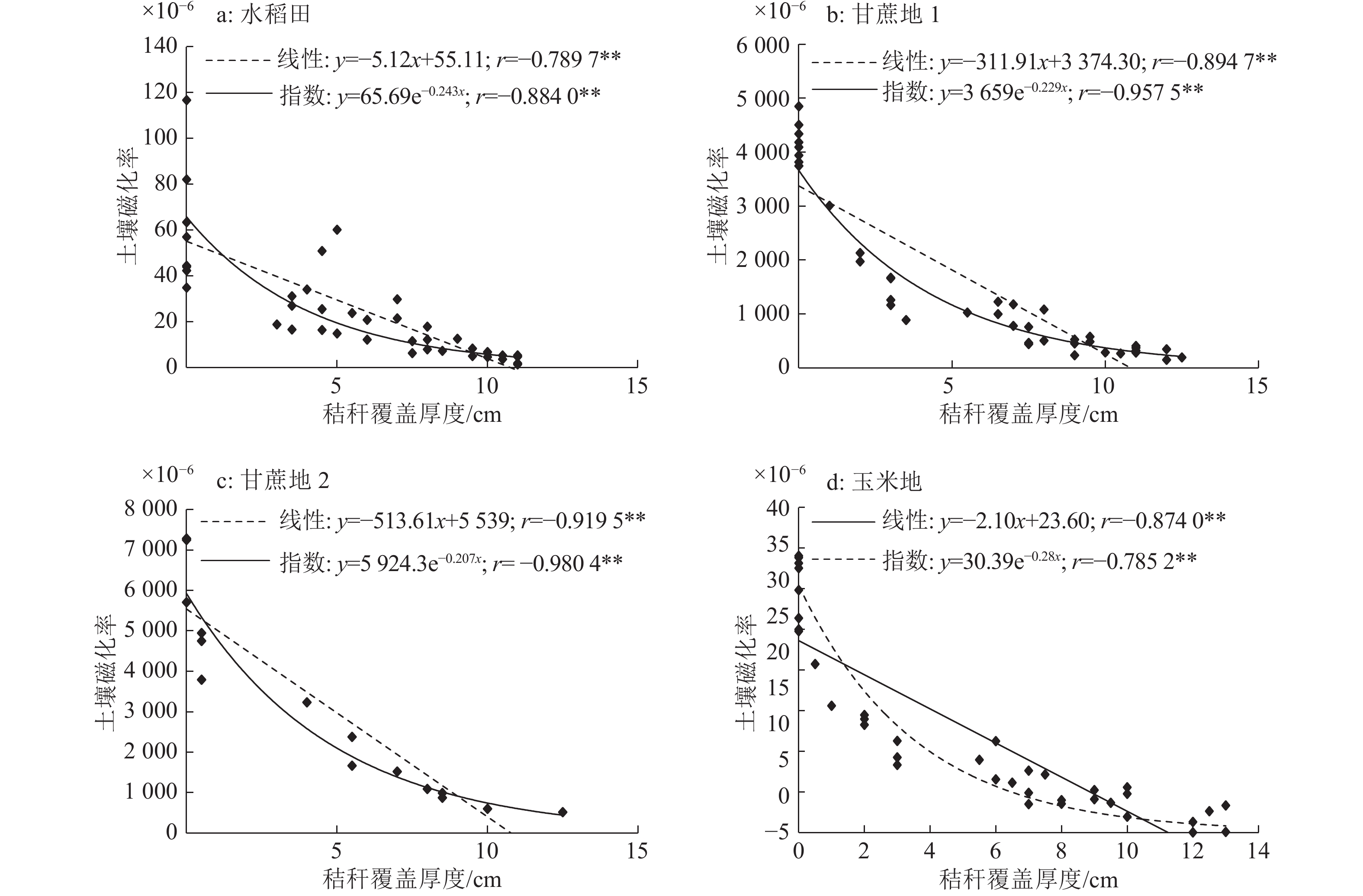Influence of straw mulching on the measurement result of farmland soil magnetic susceptibility
-
摘要:目的
土壤磁化率是环境污染监测领域的常用参数,一般在裸土表面测量。农田土壤通常覆盖有作物秸秆,本文主要研究作物秸秆覆盖对农田土壤磁化率测量的影响。
方法在水稻田、甘蔗地1、甘蔗地2和玉米地4块试验田分别设置测量点并人为均匀叠加秸秆,测量不同秸秆材质和覆盖厚度下农田土壤磁化率,分析秸秆覆盖对农田土壤磁化率测量的影响。
结果随秸秆覆盖厚度的增加土壤磁化率不断减小,当厚度在0~5 cm时,磁化率测量值迅速衰减,但其值可在一定程度上反映裸土磁化率;当厚度超过6 cm时,磁化率测量值衰减趋缓;当超过10 cm时,磁化率测量值趋于0。试验中大部分测量点数据可用指数模型拟合,少数测量点用线性模型拟合。分别整合水稻田、甘蔗地1、甘蔗地2和玉米地所有测量点的数据,土壤磁化率与秸秆覆盖厚度之间分别表现为指数、指数、指数和线性负相关。不同秸秆覆盖厚度所对应的检测距离是造成土壤磁化率测量值衰减的主要因素,秸秆本身材质对测量值影响很小。
结论利用MS2D型磁化率仪测量农田土壤磁化率时,最好直接对裸土进行测量,如果有秸秆覆盖,覆盖厚度不宜超过5 cm。秸秆覆盖厚度对土壤磁化率测量值的影响可用指数或线性负相关函数模型表征。
Abstract:ObjectiveThe soil magnetic susceptibility is a common parameter for monitoring environmental pollution, and usually measured on the surface of bare soil. The farmland soil is often covered with crop straw, and this paper mainly studies the influence of straw mulching on farmland soil magnetic susceptibility measurement.
MethodThe measuring points were set in paddy field, sugarcane field 1, sugarcane field 2 and corn field respectively, and piled up with straws artificially and evenly. The soil magnetic susceptibility values were measured under different straw materials and straw mulching thicknesses to analyze the influence of straw mulching on farmland soil magnetic susceptibility measurement.
ResultThe soil magnetic susceptibilities decreased constantly with the increase of straw mulching thickness. When the thicknesses ranged from 0 to 5 cm, soil magnetic susceptibilities attenuated rapidly, but the values could reflect the magnetic susceptibility of bare soil to a certain extent. When the thicknesses exceeded 6 cm, soil magnetic susceptibilities attenuated slowly and when the thicknesses exceeded 10 cm, soil magnetic susceptibilities tended to zero. The test data of most measuring points were fitted with index model, while that of a few points were fitted with linear model. Data of all measuring points in paddy field, sugarcane field 1, sugarcane field 2 and corn field were respectively integrated, and the relationships between soil magnetic susceptibility and straw mulching thickness in above fields were characterized by index, index, index and linear negative correlations. The corresponding detection distances of different straw mulching thicknesses were the main factors causing the attenuation of soil magnetization susceptibilities, and the influences of straw materials on the measured value were very small.
ConclusionWhen measuring soil magnetic susceptibility with MS2D magnetic susceptibility meter, it is best to measure bare soil directly. If there is straw mulching, the mulching thickness should not exceed 5 cm. The influence of straw mulching thickness on soil magnetic susceptibility can be characterized by index function or linear negative correction model.
-
Keywords:
- farmland /
- soil magnetic susceptibility /
- straw mulching thickness /
- fitting model
-
随着全国经济水平的提高,人类活动产生较多污染物质,突出的环境问题对生态系统安全及人类健康构成威胁。传统环境污染监测主要采用化学元素分析法,新兴的环境磁学技术以简便、快速、经济、不破坏样品和无污染等诸多化学元素分析法无法比拟的优势,广泛应用于环境污染监测领域。磁化率是环境磁学中最基本最易获取的磁学参数,已有大量研究利用土壤磁化率指示环境污染程度[1-5]。工业燃煤和钢铁冶炼等会产生大量磁相关颗粒污染物,并以大气沉降或人为倾倒的形式沉积于土壤表层,造成土壤重金属含量及磁性矿物含量增高。基于土壤磁化率与重金属之间的强相关性,土壤磁化率可有效指示土壤重金属污染程度[6-8]。污染土壤与未污染土壤具有明显不同的磁化率特征,利用磁化率可识别土壤是否被污染,并圈定污染范围[9-10]。
国内外利用磁化率监测城市和工业区等土壤污染现象已有大量报道[11-14],而对直接影响农产品安全的农田土壤污染方面的研究相对较少。这与农田土壤本身的复杂性有关,农业区一般距外源磁性物排放较多的城市区、工业区较远,土壤的磁化率背景较低;农业耕作土壤经过翻耕或灌溉,扰动并“稀释”了人为活动产生的磁性颗粒[15-18]。大量研究证明农田土壤磁化率可以有效评估农田土壤质量,并指出人为因素是影响农田土壤磁化率高低的关键因素[19-20]。国外研究公路旁农田土壤磁化率特征时发现,距离公路越近的农田其磁化率增高趋势越明显[21],可见农田土壤磁化率能有效指示交通尾气排放等引起的土壤污染。
农田环境通常区别于其他环境,农作物收获后,土壤表面通常会有秸秆覆盖。传统的土壤磁化率测量方式是挪移作物秸秆后再测量裸土磁化率,这在大面积监测农田土壤时会费时费力,因此需要研究秸秆覆盖对土壤磁化率测量的影响,目前此类的报道还比较少见。本文选取不同作物试验田,以秸秆覆盖厚度为试验因素,研究其对测量农田土壤磁化率的影响,为农田土壤磁化率监测技术研究提供参考。
1. 材料与方法
1.1 研究区概况
本研究选取的4块试验田位于广东省3个不同地区(E109°39′~117°19′,N20°13′~25°31′),分别为肇庆市鼎湖区水稻田、湛江市徐闻县甘蔗地1、湛江市遂溪县甘蔗地2和广州市增城区玉米地[22]。各试验田地理位置及测量样点分布如图1所示。各试验田作物收获后,秸秆覆盖地表基本情况如图2所示。
1.2 测定方法
采用英国Bartington公司的MS2D型磁化率仪测量土壤表层体积磁化率,即土壤磁化率。测量系统仪器设备如图3所示,主要包括MS2D磁化率测量仪、Trimble 5700 GPS系统以及PC机。
试验时,除甘蔗地2为5个测量点外,其余各试验田内随机设置10个测量点,每个测量点均以裸土开始测量土壤磁化率,以约3 cm秸秆厚度为间隔梯度进行人为堆叠作物秸秆,依次均匀叠加4次,堆叠面积大于土壤磁化率测量仪测量线圈(直径为185 mm)的面积。测量时,以人为自然力通过探测手柄将MS2D探测线圈压在秸秆表面,记录实际测得的秸秆覆盖厚度,同时记录各测量点在不同秸秆覆盖厚度下的土壤磁化率。
1.3 数据处理
首先根据各试验田测量点在不同秸秆覆盖厚度下的土壤磁化率数据,选用Excel中的不同数学模型对每个测量点的土壤磁化率与秸秆覆盖厚度进行拟合,通过对比,选取拟合度最高的模型作为该点的最优拟合模型。然后对各试验田的所有测量点数据进行整合,观察各试验田的土壤磁化率与秸秆覆盖厚度间的关系,并通过实测数据验证拟合模型的可靠性。
2. 结果与分析
2.1 测量点土壤磁化率数据及拟合模型
4块试验田的各个测量点在不同秸秆覆盖厚度下土壤磁化率均值及标准偏差分布结果如图4所示,其中秸秆厚度0 cm的土壤磁化率为裸土条件下测得的土壤磁化率。
由图4以及各测量点的散点及其土壤磁化率与秸秆覆盖厚度之间相关性拟合曲线(图略)可知,所有测量点的土壤磁化率均随秸秆覆盖厚度的不断增加而逐渐减小。当厚度增加到3 cm时,磁化率测量值衰减了50%左右;当厚度继续增加到6 cm时,磁化率值衰减了70%左右,之后,衰减变化趋于平缓;当厚度增至10~12 cm时,水稻田、甘蔗地1、甘蔗地2的土壤磁化率普遍衰减至趋于0,玉米地出现3个负值。究其原因,国外相关研究指出地表的苔藓、植被和落叶对土壤磁化率有降低作用,视为抗磁性[23]。本研究中作物秸秆抗磁性对土壤磁化率有削弱作用,同时玉米地裸土磁化率水平不高,厚实的秸秆对土壤磁化率的削弱作用将超过土壤磁性颗粒对磁化率的贡献作用,故导致玉米地土壤磁化率出现负值。不同的覆盖作物材质如水稻、甘蔗和玉米秸秆对土壤磁化率测量的衰减作用与趋势是相同的,差异不显著。
4块试验田各测量点土壤磁化率与秸秆覆盖厚度间拟合模型的相关系数均在0.871~0.998之间。由相关系数检验表[23]可知,除了玉米地有1个测量点外,其他测量点以及水稻田和甘蔗地所有测量点的相关系数均在显著或极显著负相关的范围内,说明土壤磁化率与秸秆覆盖厚度密切相关,二者可建立可靠的拟合模型。
从各测量点的散点图及拟合曲线可知(图略),甘蔗地1与甘蔗地2全部测量点的土壤磁化率与秸秆覆盖厚度之间均为指数模型;水稻田和玉米地大部分为指数模型,个别为线性模型。此外,由于玉米地有2个测量点的土壤磁化率为负值,为了表达土壤磁化率的变化范围,直接采用了线性模型。
2.2 不同农田作物秸秆覆盖厚度下土壤磁化率的特征
从同一块试验田10个测量点中随机选取8个测量点将其数据整合在一起(另外2个点用作模型检验数据),考查4块试验田在不同作物秸秆覆盖下,其整体土壤磁化率随秸秆覆盖厚度变化的特征。选用指数方程和线性方程进行拟合对比,结果如图5所示(拟合度高的用实线,低的用虚线)。
由图5可见,各拟合方程的相关系数均在极显著范围内。水稻田的土壤磁化率–秸秆覆盖厚度关系的指数模型相关系数(0.884 0)大于线性模型(0.789 7),二者呈指数负相关,方程为y=65.69e–0.243x。
甘蔗地1、甘蔗地2的土壤磁化率–秸秆覆盖厚度关系也可选用指数模型,二者呈指数负相关,相关性较高,拟合方程分别为y=3 659e–0.229x和y=5 924.3e–0.207x,相似度较高。
分析玉米地数据时,剔除了数据为负值的处理,得到的玉米地土壤磁化率–秸秆覆盖厚度关系的线性模型相关系数(0.874 0)大于指数模型(0.785 2),二者呈线性负相关,方程为y=–2.100 2x+23.601。若不剔除负值,玉米地采用线性模型拟合,其所有10组数据或者部分数据拟合的相关系数均在0.78~0.99之间变化,也具有较高的相关性。
通过以上分析可知,随着秸秆覆盖厚度的增加,4块试验田土壤磁化率衰减趋势相似,总体表现为:当秸秆覆盖厚度为0~5 cm时,土壤磁化率快速衰减,其值尚可关联反映裸土磁化率(其中,同一试验田中各测量点的裸土磁化率也有不同,反映了同一试验田中各点磁性矿物含量的差异对磁化率的影响);当厚度超过6 cm时,土壤磁化率衰减趋于平缓;当厚度超过10 cm时,土壤磁化率普遍接近0,玉米地甚至出现负值。探究覆盖秸秆过于厚实后磁化率接近0的主要原因是:MS2D磁化率探头与被测土壤之间的距离已经接近仪器的最大响应距离14 cm[25],导致MS2D磁化率仪较难响应表层土壤的磁性颗粒,因而测得磁化率数值较小。
2.3 拟合模型的检验
基于以上的相关性分析,利用每块试验田剩余的2个测量点的数据进行拟合模型的检验。图6分别是校正(拟合)模型和检验模型在4块试验田中的实测值与预测值(1∶1)关系图,用于检验拟合模型的可靠性和一致性。其均方根误差(RMSE)计算公式如下:
$${\rm {RMSE}} = \sqrt {\frac{1}{{{n_c}}}\sum\limits_{i = 1}^{{n_c}} {{{\left( {{{\hat y}_i} - {y_i}} \right)}^2}} } ,$$ (1) 式中,
${\hat y_i}$ 是实测值,${y_i}$ 是预测值,${n_c}$ 是样本数。由图6可见,除了水稻田校正模型的实测值与预测值之间的相关系数rc(0.796 6)偏低外,其检验模型相关系数rv及其余田块的rc、rv值均较高,且所有的相关系数均在极显著范围内,说明所建立的模型是可靠的。除甘蔗地2校正模型的rc高于验证模型的rv外,其余田块校正模型的rc均低于验证模型的rv,主要是拟合模型对裸土磁化率的拟合度比较低造成的,这从侧面反映了试验田田间裸土磁化特征的复杂性。
甘蔗地裸土的土壤磁化率值较大,其均方根误差值也相对偏大,但所有田块校正模型和检验模型的均方根误差相对于各自最大坐标值均在5%~15%之间。
由研究结果可知,如果是在有农作物秸秆覆盖的条件下测量土壤磁化率,秸秆覆盖对磁化率测量值的衰减作用是不容忽视的,文中所建立的模型在实践应用中可作为参考。然而,秸秆覆盖同时包含2个因素,一个是覆盖厚度,即检测距离,另一个是秸秆材质,哪一个因素对土壤磁化率的测量影响更大呢?对此我们在肇庆市鼎湖区水稻田里进行了在不同检测高度(无任何覆盖物,以3 cm的高度为间隔梯度)和相对应的秸秆覆盖厚度条件下测量土壤磁化率的对比试验,试验重复10次(10个不同的测量点)。试验结果如图7所示。
通过图7可知,距离土壤地表面的检测距离是造成土壤磁化率测量值衰减的主要因素,秸秆覆盖物材质对测量值的影响很小。这也进一步说明了前文中为什么不同作物秸秆覆盖条件下土壤磁化率与秸秆覆盖厚度间关系的拟合模型是相似的。
3. 结论
1)水稻田、甘蔗地1、甘蔗地2和玉米地大部分测量点的土壤磁化率与秸秆覆盖厚度表现为指数负相关,少部分测量点表现为线性负相关。
2)水稻田、甘蔗地1、甘蔗地2和玉米地的农田整体土壤磁化率–秸秆覆盖厚度拟合模型分别为指数、指数、指数和线性,其方程式分别为:y=65.69e–0.243x、y=3 659e–0.229x、y=5 924.3e–0.207x和y= –2.10x+23.60。
3)秸秆厚度为0~5 cm时,土壤磁化率随秸秆覆盖厚度的增加迅速减小;厚度超过6 cm时,土壤磁化率的衰减减缓;厚度超过10 cm时,土壤磁化率趋于0,玉米地甚至出现负值,这与前期试验[22]一致。0~5 cm秸秆厚度范围内测量到的土壤磁化率与裸土磁化率的变化趋势较为相似,尚可反映裸土磁化率特征,为了保证MS2D磁化率仪测量到的表层土壤磁化率可以较好地表征裸土磁化率,建议在秸秆覆盖厚度不超过5 cm的农田中使用MS2D磁化率仪进行测量。
4)在模型的校正与检验中,校正模型的rc均在0.79以上,验证模型的rv均在0.90以上,均在极显著范围内,均方根误差值也相对偏小,说明所建立的土壤磁化率测量值与秸秆覆盖厚度间的拟合模型是可行的。
5)在有秸秆覆盖的测量中,秸秆覆盖引起的检测距离增大是造成土壤磁化率测量值衰减的主要因素,秸秆材质本身对测量值影响很小。
-
-
[1] THOMPSON R, OLDFIELD F. Environmental magnetism[M]. London: Allen and Unwin, 1986: 1-227.
[2] OLDFIELD F. Environmental magnetism: A personal perspective[J]. Quat Sci Rev, 1991, 10(1): 73-85.
[3] LIU Q, ROBERTS A P, LARRASOANA J C, et al. Environmental magnetism: Principles and applications[J]. Rev Geophys, 2012, 50(4). doi: 10.1029/2012RG000393
[4] 刘青松, 邓成龙. 磁化率及其环境意义[J]. 地球物理学报, 2009, 52(4): 1041-1048. [5] 张春霞, 黄宝春. 环境磁学在城市环境污染监测中的应用和进展[J]. 地球物理学进展, 2005, 20(3): 705-711. [6] 段雪梅, 胡守云, 闫海涛, 等. 南京某钢铁公司周边耕作土壤的磁学性质与重金属污染的相关性研究[J]. 中国科学(D辑: 地球科学), 2009, 39(9): 1304-1312. [7] HANESCH M, SCHOLGER R. Mapping of heavy metal loadings in soils by means of magnetic susceptibility measurements[J]. Environ Geol, 2002, 42(8): 857-870.
[8] 陈轶楠, 张永清, 张希云, 等. 晋南某钢厂周边土壤重金属与磁化率分布规律及其相关性研究[J]. 干旱区资源与环境, 2014, 28(1): 85-91. [9] 旺罗, 刘东生, 吕厚远. 污染土壤的磁化率特征[J]. 科学通报, 2000, 45(10): 1091-1094. [10] HAY K L, DEARING J A, BABAN S M J, et al. A preliminary attempt to identify atmospherically-derived pollution particles in English topsoils from magnetic susceptibility measurements[J]. Phys Chem Earth, 1997, 22(1/2): 207-210.
[11] 卢瑛, 龚子同, 张甘霖. 城市土壤磁化率特征及其环境意义[J]. 华南农业大学学报, 2001, 22(4): 26-28. [12] 赵庆磊, 李凤全, 王天阳, 等. 金华城区表层土壤剖面磁化率变化规律[J]. 水土保持研究, 2015, 22(2): 340-344. [13] 闫倩, 戴霜, 刘海娇, 等. 兰州某钢厂附近土壤磁化率特征及其环境意义[J]. 中国环境科学, 2011, 31(10): 1732-1737. [14] STRZYSZCZ Z, MAGIERA T. Magnetic susceptibility and heavy metals contamination in soils of Southern Poland[J]. Phys Chem Earth, 1998, 23(9/10): 1127-1131.
[15] STRZYSZCZ Z, MAGIERA T. Record of industrial pollution in Polish ombrotrophic peat bogs[J]. Phys Chem Earth A, 2001, 26(11/12): 859-866.
[16] 周鸿斌, 角媛梅, 史正涛, 等. 云南沘江沿岸农田土壤磁测分析与重金属污染评价[J]. 农业环境科学学报, 2008, 27(4): 1586-1591. [17] 李晓庆, 胡雪峰, 孙为民, 等. 城市土壤污染的磁学监测研究[J]. 土壤, 2006, 38(1): 66-74. [18] 陈秀玲, 李志忠, 姜修洋, 等. 福州盆地不同土地利用方式下土壤磁化率特征[J]. 福建师范大学学报 (自然科学版), 2012, 28(3): 87-93. [19] 欧阳婷萍, 万洪富, 张金兰, 等. 珠江三角洲农业土壤磁化率空间分布特征及其影响因素分析[J]. 第四纪研究, 2012, 32(6): 1199-1206. [20] 吴丹, 欧阳婷萍, 匡耀求, 等. 佛山农业表层土壤磁化率特征及其与重金属含量的关系[J]. 生态环境学报, 2014, 23(11): 1826-1831. [21] BAGHDAD M E, JAKANI K, BARAKAT A, et al. Magnetic susceptibility and heavy metal contamination in agricultural soil of Tadla plain[J]. J Mater Environ Sci, 2011, 2(S1): 513-519.
[22] 黄倩. 秸秆覆盖对农田土壤磁化率影响的研究[D]. 广州: 华南农业大学, 2016. [23] BOYKO T, SCHOLGER R, STANJEK H. Topsoil magnetic susceptibility mapping as a tool for pollution monitoring: Repeatability of in situ measurements[J]. J Appl Geophy, 2004, 55(3/4): 249-259.
[24] 王颉. 试验设计与SPSS应用[M]. 北京: 化学工业出版社, 2006. [25] DEARING J A. Environmental magnetic susceptibility: Using the Bartington MS2 system[M]. Kenilworth: Chi Publishing, 1994.




 下载:
下载:










